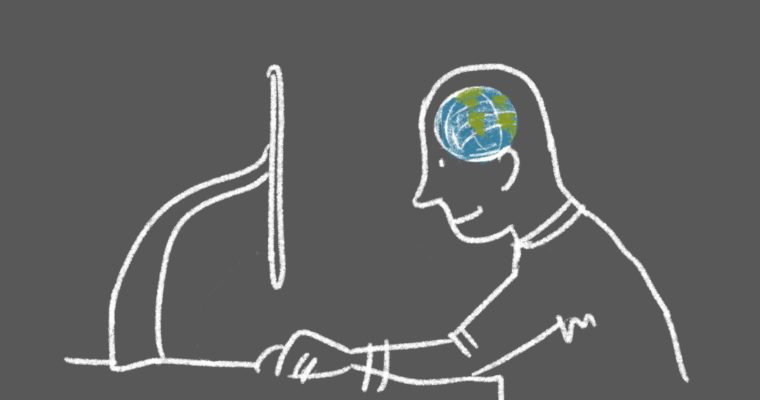It seems only realistic to say that we’re doomed. We can no longer picture things turning out okay, and that’s the very problem. In From What Is to What If, Rob Hopkins argues that until we can imagine a bright future, it is very hard to build one.
What does this mean for us as economists?
Hopkins explains how imagination got lost, how we could get it back, and why doing so is crucial. He encourages ordinary citizens to stop waiting on think tanks and governments to lead the transition to a sustainable future. We should open ourselves to play, to the arts, and to storytelling as pathways to regain a sense of possibility. We’ll be surprised, he says, how much easier things are to execute once they’ve been imagined vividly.
If you’re a very pragmatic, data-driven person, reading Hopkins may feel like you’re being pulled onto a dance floor against your will. But there’s a lot to learn from him, especially for us economists, since our imaginations face unusually strong opposition.
The situation
Hopkins finds that with less and less time for play, children lose their imagination quicker and quicker. “They knew what a fronted adverbial noun was,” a secondary school teacher tells him, “but when I set them a task to write a story, they broke down and cried.” And if schooling makes the first blow to a child’s imagination, smartphones make the next. By taking away our opportunity to be bored, our minds have no time to ponder. Adulthood doesn’t make things easier. At that stage, we’re meant to be productive. Arts, play, and improvisation are considered frivolous, silly, and completely unhelpful to the growth-maximizing system we’ve built.
For me, it’s a message that hits home. Living in fast-paced New York City, I often fell into the trap of doing increasing levels of busywork. I’d be patting myself on the back for how much I’m getting done, while slowly eroding my ability to contribute new insights and fresh perspectives. Allowing for quiet time and idleness seemed almost sinful. Until I finally noticed how many ideas I was getting in the bathtub. We’re all afraid of robots catching up to us, but if we’re not careful, we might reduce ourselves to their level first.
Hopkins’ solution
The good news is that our imagination, once lost, can be found again. Hopkins cites numerous examples of communities that have gathered to reignite their imagination and visualize how a sustainable future could look. Just one afternoon with cardboard and chalk and conversation already proved transformative. It also brought back a sense of possibility. And once people had imagined their street corner to contain an herb garden, they never looked at it the same way. Oftentimes, they found themselves making it a reality; surprised at the things that had seemed impossible but weren’t.
Of course, the power of local communities remains limited by the overarching powers and structures of the state. Hopkins acknowledges that readily. Therefore, he points out that extractive systems—such as towns that are centered around an Amazon fulfillment center—crush the imagination. Better to keep revenue streams local, allowing people to enjoy the fruits of their own labor, and to shape local economies according to local needs. UBI also gets a mention, for being able to maintain a standard of living. After all, it’s hard to be imaginative if you’re just trying to survive.
Imagination for Economists
So, what does imagination for economists mean for us as new economic thinkers? Hopkins might not even realize. However, if there’s any place where imagination gets crushed, it’s in the economics textbook. Students who are keen to improve the economy for the better are told that it’s not an economist’s job to “save the world”. Instead, it’s economists’ job to develop objective scientific tools that can be used by whoever else wants to save the world. As if we’re doing physics. Which we’re not.
This way, mainstream economics presents a real problem for anyone trying to put this advice to work.
Whatever imagination will be reignited, economists will stand ready to crush as unrealistic, and naive. So, those with vivid imaginations might want to set the ‘objective’ tools aside and follow Hopkins’ lead for some time. However, most economists will declare that if you’re not using their favorite method, it’s not economics, and therefore not worth taking very seriously.
However, as the next generation of economists, we can help each other. We can also nourish our imaginations, and encourage our peers to do the same. We can talk about how it could feel to trust your bank, and what would be required for that to be the case. Moreover, we can picture how we’d like to grow old, and think backward for what that might necessitate. We can draw images of the public infrastructure we’d want, and see what it would require to build. Furthermore, we can reassure each other that by doing all that, we’re doing economics.
So, let’s use not just our data, our mathematics, and our analysis. Let’s also use our imagination. Because once we collectively imagine the economy we want, half our work will be done.
About the Author | Heske van Doornen is Manager of the Young Scholars Initiative and co-founder of this blog. Twitter: @HeskevanDoornen
Buy the Book | From What Is to What If: Unleashing the power of imagination to create the future we want by Rob Hopkins, Chelsea Green Publishing (2020)
Want to review a book you read? YSI will reimburse you for the price of the book, and will consider your piece for publication on Economic Questions. Reach out to contact@economicquestions.org to get started.



